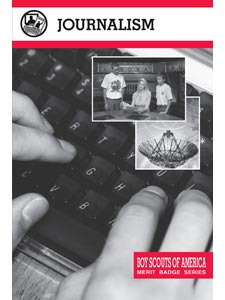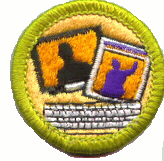- Explain what freedom of the press is and how the First Amendment guarantees that you can voice your opinion. In your discussion, tell how to distinguish between fact and opinion, and explain the terms libel, slander, defamation, fair comment and criticism, public figure, privacy, and malice. Discuss how these matters relate to ethics in journalism.
Do ONE of the following:- Read a local newspaper, a national newspaper, a newsmagazine, and a computerized online news source. From each of these, clip stories about the same event. Put each item on a separate piece of paper. Write an analysis comparing the different stories explaining how the stories are objective or subjective and how each publication handled the story differently depending on its purpose or audience.
- All on the same day, watch a local television newscast, watch a national network newscast, listen to a radio newscast, and study the computerized online news provided by a national news broadcast source. List the different news items, features, and editorials on the broadcasts, including the time in minutes and seconds devoted to each story, and print out a copy of the online edition's "front page." Write an analysis comparing the different story lists, explaining how the stories are objective or subjective and why different news outlets treated the stories differently.
- Do either a OR b:
- Print
Newspaper and magazine
journalism:
- All on the same day, read a local newspaper, a national newspaper, a newsmagazine, and (with your parent's permission) an online news source. From each source, clip, read, and compare a story about the same event. Tell your counselor how long each story is and how fair and accurate the stories are in presenting different points of view. Tell how each source handled the story differently, depending on its purpose or audience
- 1. Visit a newspaper
or magazine office
Ask for a
and
tour of the various divisions
, including the newsroom, the
(editorial
offices the business
side, and
the printing
)
plant. During your tour, talk to an
editor or reporter about what it's like to be a newspaper journalist, where they get story ideas, and what makes a good newspaper. If possible, go with a reporter and your buddy to cover a news event. Get your parent's permission first.
executive from the business side about management's relations with reporters, editors, and photographers and what makes a "good" newspaper or magazine.
2. With the help of your counselor, prepare a front-page newspaper layout. Edit copy, proofread a story after it has been typeset, and be able to explain the printing process.
-
Broadcast
Radio and television journalism:
- All on the same day, watch a local and national network newscast, listen to a radio newscast, and (with your parent's permission) view a national broadcast news source online. List the different news items and features presented, the different elements used, and the time in minutes and seconds and the online space devoted to each story Compare the story lists, and discuss whether the stories are fair and accurate. Explain why different news outlets treated the stories differently and/or presented a different point of view.
- 1. Visit a radio or television station
. Ask for a
and tour
of the various
departments, concentrating on those related to news broadcasts
divisions, including the newsroom, the studios, the control rooms, and the business side. During your tour, talk to the
station manager or other station management executive about station operations, particularly how management and the news staff work together
a producer or reporter about what it's like to be a broadcast journalist, where they get story ideas, and what makes a
"good
" station. If possible, go with a reporter
and your buddy to cover a news event.
Get your parent's permission first.
2. With the help of your counselor prepare a television or radio news show format. Edit audiotape or videotape, and be able to explain what it takes to broadcast radio or television news.
- Print
Newspaper and magazine
journalism:
- Discuss the differences between a hard news story and a feature story. Explain what is the "five W's and H." Then do ONE of the following:
- Choose a current or an unusual event of interest to you, and write either a hard news article OR a feature article about the event. Gear the article for print OR audio OR video journalism. Share your article with your counselor.
- With your parent's permission and counselor's approval, interview someone in your community who is influential because of his or her leadership, talent, career, or life experiences. Then present to your counselor either a written or oral report telling what you learned about this person.
- With your parent's permission and counselor's approval, read an autobiography written by a journalist you want to learn more about. Write an article that tells what you learned about this person and the contributions this person has made to the field of journalism.
- Attend a Scouting event and write a 200-word article (feature or hard news) about the event. Use either the inverted pyramid style or the chronological style. Review the article with your counselor, then submit it to your community newspaper or BSA local council or district newsletter for consideration.
- 3. Attend a
public
news event and do ONE of the following:
- Write two a newspaper articles story about the event, one using the inverted pyramid style and one using the chronological style a sidebar feature, and either an editorial or a critical review of the event.
- Using a radio or TV television broadcasting style write a news story about the event, a feature color story and either an editorial or a critical review of the event.
- Take a series of photographs that would help to help tell the story of the event in pictures. , including some Include news photos and some feature photos in your presentation. Write cutlines for your photos and a brief story synopsis of the event as well as captions for your photos.
- 4. Answer at least three of five questions about qualifications, educational preparations, training opportunities, wages, and personal satisfaction in journalism.
Find out about three career opportunities in journalism. Pick one and find out the education, training, and experience required for this profession. Discuss this with your counselor, and explain why this profession might interest you.
BSA Advancement ID#:
66
Requirements last updated in:
2007
Pamphlet Publication Number:
33350B
Pamphlet Revision Date:
2006
| Worksheets for use in working on these requirements: | Format | |
|---|---|---|
| Word Format | PDF Format | |
Page updated on: November 18, 2021









